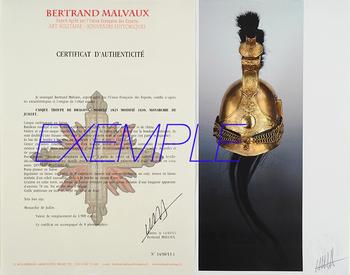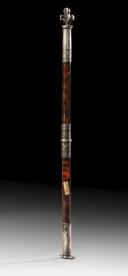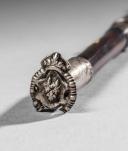
Command baton or royal function baton, Old Monarchy, 17th century (probably). COLLECTION PHILIPPE MISSILLIER, Auction House Giquello, Drouot - rooms 5-6, March 6 & 7, 2025.
Sold out
COLLECTION PHILIPPE MISSILLIER
EARLY PERIOD – BOOKS – FIREARMS FROM THE 17TH CENTURY
HUNTING ART – PHALERISTICS
WEAPONS FROM THE 18TH AND 19TH CENTURIES – RUSSIAN ART
Friday, March 7, 2025 - 11am to 12pm
AFRICA AND OCEANIA – FAR EAST
Friday, March 7, 2025 - 2pm
ISLAMIC AND INDIAN ART
Drouot - rooms 5-6
EXHIBITION
Tuesday, March 4 from 11am to 6pm
Wednesday, March 5 from 11am to 6pm
Thursday, March 6 from 11am to 12pm
Phone during the exhibition +33(0)1 48 00 20 05
GIQUELLO
Alexandre Giquello
Violette Stcherbatcheff
5, rue La Boétie - 75008 Paris
+33 (0)1 47 42 78 01 - info@giquello.net
with approval
no.2002 389
CONTACT
Claire Richon
+33(0)1 47 70 48 00
c.richon@giquello.net
EXPERT
Bertrand Malvaux, CNES
Lot n° 184 (from the sale)
Command or royal function baton, Old Monarchy, 17th century (probably).
In horn with three silver fittings in the shape of molded rings.
Top fittings 5.2 cm enriched with a heraldic fleur-de-lis at the end of 2.1 cm; central fitting 4.7 cm; lower fitting 5 cm applied with the coat of arms of the House of France and Navarre and the collar of the Order of the Holy Spirit. Total length 36.2 cm. Gross weight: 90 gr.
France.
17th century.
Good condition.
3000/5000
Provenance: 1903 Theresianumgasse Inventory, p. 131, no. 331;
1934 Theresianumgasse Inventory, p. 278, no. 30.
Collection of Barons Nathaniel and Albert de Rothschild, Vienna (Austria), Rothschild inv. no. AR1398.
Christie's London Sale, July 8, 1999, no. 52.
Note: This specimen is difficult to identify definitively. However, its typology is similar to that of the baton of Marshal de Bellefonds, from the second half of the 17th century, in ebony and vermeil, (length 55 cm, diameter 4 cm), collections of the Army Museum, Hôtel des Invalides in Paris (Inv. 04495/code Ib 1 MOK). It also consists of three fittings, much more richly decorated, with two heraldic fleur-de-lis ends. Although not attributable to a high function, it falls within the insignia of command or official function.
An article written by Mr. François Lagrange: “Signs of military power: from the constable's sword to the marshal's baton” (https://doi.org/10.4000/crcv.11815), demonstrates that batons are symbols of power, well before the creation of marshal's batons:
"For the period roughly corresponding to the Renaissance to the end of the Old Regime, two types of objects can claim to symbolize military power in its highest expressions: the constable's sword and the marshal's baton.
In the modern era, there are numerous examples proving that the baton (insignia of supreme military power) does not strictly belong to marshals.
In the 18th century, the King of France is portrayed with a command baton, sometimes with fleurs-de-lis, as for Louis XV, King of France and Navarre, sometimes without apparent ornamentation, as for King Louis XV in campaign.
Great figures, who do not hold the title of marshal, carry a command baton. The Army Museum acquired a portrait in 2007 of Louis II de Bourbon, Duke of Enghien, in front of the battlefield of Rocroi, showing him holding a command baton (without fleurs-de-lis).
In this case, the Army Museum also houses the command baton of Jean-Baptiste de Cassagnet, Marquis of Tilladet, captain-lieutenant of the Hundred Swiss, killed in 1692 at the Battle of Steenkerque.
The only true batons of Marshals of France would only appear from 1758 when the type was defined at the initiative of Marshal de Belle-Isle, then Minister of War under Louis XV.
Another piece of evidence of the existence of marshal's batons is related to the presence, in the collections of the Army Museum, of the command baton of Bernardin Gigault, Marquis of Bellefonds (1630-1694), who became Marshal of France in 1668.
Its typology is very interesting: each end bears a fleur-de-lis in 'quasi-round-boss'; then, moving towards the center, on each side there is a cylindrical metal sheath adorned with a semé of fleurs-de-lis; then, after an intermediate part without metal revealing the bare ebony wood, once again, at the center of the baton, a metal sheath with on one side the monogram and on the other the arms of the Marquis - which both brings it closer and distinguishes it from the regulatory batons of the 18th century to which it is much earlier.
This object is open to multiple interpretations. Relying on symbolic similarities, Colonel Paul Willing, curator at the Army Museum in 1979, sees it as a clear precursor to the marshal's baton in use from 1758."
EARLY PERIOD – BOOKS – FIREARMS FROM THE 17TH CENTURY
HUNTING ART – PHALERISTICS
WEAPONS FROM THE 18TH AND 19TH CENTURIES – RUSSIAN ART
Friday, March 7, 2025 - 11am to 12pm
AFRICA AND OCEANIA – FAR EAST
Friday, March 7, 2025 - 2pm
ISLAMIC AND INDIAN ART
Drouot - rooms 5-6
EXHIBITION
Tuesday, March 4 from 11am to 6pm
Wednesday, March 5 from 11am to 6pm
Thursday, March 6 from 11am to 12pm
Phone during the exhibition +33(0)1 48 00 20 05
GIQUELLO
Alexandre Giquello
Violette Stcherbatcheff
5, rue La Boétie - 75008 Paris
+33 (0)1 47 42 78 01 - info@giquello.net
with approval
no.2002 389
CONTACT
Claire Richon
+33(0)1 47 70 48 00
c.richon@giquello.net
EXPERT
Bertrand Malvaux, CNES
Lot n° 184 (from the sale)
Command or royal function baton, Old Monarchy, 17th century (probably).
In horn with three silver fittings in the shape of molded rings.
Top fittings 5.2 cm enriched with a heraldic fleur-de-lis at the end of 2.1 cm; central fitting 4.7 cm; lower fitting 5 cm applied with the coat of arms of the House of France and Navarre and the collar of the Order of the Holy Spirit. Total length 36.2 cm. Gross weight: 90 gr.
France.
17th century.
Good condition.
3000/5000
Provenance: 1903 Theresianumgasse Inventory, p. 131, no. 331;
1934 Theresianumgasse Inventory, p. 278, no. 30.
Collection of Barons Nathaniel and Albert de Rothschild, Vienna (Austria), Rothschild inv. no. AR1398.
Christie's London Sale, July 8, 1999, no. 52.
Note: This specimen is difficult to identify definitively. However, its typology is similar to that of the baton of Marshal de Bellefonds, from the second half of the 17th century, in ebony and vermeil, (length 55 cm, diameter 4 cm), collections of the Army Museum, Hôtel des Invalides in Paris (Inv. 04495/code Ib 1 MOK). It also consists of three fittings, much more richly decorated, with two heraldic fleur-de-lis ends. Although not attributable to a high function, it falls within the insignia of command or official function.
An article written by Mr. François Lagrange: “Signs of military power: from the constable's sword to the marshal's baton” (https://doi.org/10.4000/crcv.11815), demonstrates that batons are symbols of power, well before the creation of marshal's batons:
"For the period roughly corresponding to the Renaissance to the end of the Old Regime, two types of objects can claim to symbolize military power in its highest expressions: the constable's sword and the marshal's baton.
In the modern era, there are numerous examples proving that the baton (insignia of supreme military power) does not strictly belong to marshals.
In the 18th century, the King of France is portrayed with a command baton, sometimes with fleurs-de-lis, as for Louis XV, King of France and Navarre, sometimes without apparent ornamentation, as for King Louis XV in campaign.
Great figures, who do not hold the title of marshal, carry a command baton. The Army Museum acquired a portrait in 2007 of Louis II de Bourbon, Duke of Enghien, in front of the battlefield of Rocroi, showing him holding a command baton (without fleurs-de-lis).
In this case, the Army Museum also houses the command baton of Jean-Baptiste de Cassagnet, Marquis of Tilladet, captain-lieutenant of the Hundred Swiss, killed in 1692 at the Battle of Steenkerque.
The only true batons of Marshals of France would only appear from 1758 when the type was defined at the initiative of Marshal de Belle-Isle, then Minister of War under Louis XV.
Another piece of evidence of the existence of marshal's batons is related to the presence, in the collections of the Army Museum, of the command baton of Bernardin Gigault, Marquis of Bellefonds (1630-1694), who became Marshal of France in 1668.
Its typology is very interesting: each end bears a fleur-de-lis in 'quasi-round-boss'; then, moving towards the center, on each side there is a cylindrical metal sheath adorned with a semé of fleurs-de-lis; then, after an intermediate part without metal revealing the bare ebony wood, once again, at the center of the baton, a metal sheath with on one side the monogram and on the other the arms of the Marquis - which both brings it closer and distinguishes it from the regulatory batons of the 18th century to which it is much earlier.
This object is open to multiple interpretations. Relying on symbolic similarities, Colonel Paul Willing, curator at the Army Museum in 1979, sees it as a clear precursor to the marshal's baton in use from 1758."
Reference :
Étude Giquello, Drouot - salles 5-6, les 6 & 7 mars 2025

Next update Friday, april 4th at 1:30 PM
FOR ALL PURCHASES, PAYMENT IN MULTIPLE CHECKS POSSIBLE
bertrand.malvaux@wanadoo.fr 06 07 75 74 63
An authenticity certificate of the item including the description published on the site, the period, the sale price, accompanied by one or more color photographs is automatically provided for any item priced over 130 euros. Below this price, each certificate is charged 5 euros.
Only items sold by me are subject to an authenticity certificate, I do not provide any expert reports for items sold by third parties (colleagues or collectors).

